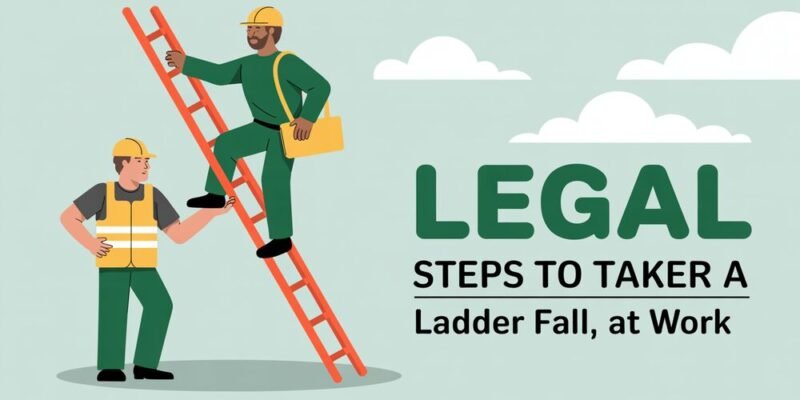One misstep. That’s all it takes for a routine task on a ladder to turn into a life-altering accident. Workplace ladder falls can lead to serious injuries, mounting medical bills, and even lost wages, but knowing the proper legal steps can make all the difference.
Among the most common construction site ladder injuries are fractures, spinal damage, and traumatic brain injuries, each with devastating consequences. If you’ve been hurt in a fall, acting quickly to protect your rights is crucial. Was negligence or unsafe conditions to blame? The path to justice starts here. Let’s break down the essential legal actions to take after a workplace ladder accident.
7 Legal Steps to Take After a Ladder Fall at Work
Report the Accident Immediately
The very first step after a ladder fall at work is to notify your employer or supervisor. Failing to report the incident promptly could weaken any future compensation claim. In most states, you must report a workplace injury within a specific timeframe—often within 30 days.
In jurisdictions like California, workers’ compensation laws require timely reporting to initiate a claim. Even if your injuries seem minor at first, a medical complication could arise later, and early documentation is key to preserving your legal rights.
Seek Medical Attention and Document Everything
After reporting the incident, seek immediate medical care. Tell your doctor the injury happened at work and be specific about how the fall occurred.
Be sure to: Keep all medical records and receipts. Follow prescribed treatments and attend follow-up appointments. Request a written diagnosis and work restrictions from your doctor.
These documents will become essential evidence in proving the extent of your injuries and how they affect your ability to work.
File a Workers’ Compensation Claim
If you’re covered under your employer’s workers’ compensation insurance, you’re entitled to medical treatment, wage replacement, and possibly vocational rehabilitation.
To file a claim: Obtain and complete the appropriate form from your employer or state labor department. Submit it within your state’s filing deadline (e.g., California: one year, New York: two years). Include details of your injury, medical treatment, and employment status.
Injured employees who receive workers’ compensation are typically barred from suing their employer directly. However, there are exceptions in cases involving intentional harm or gross negligence.
Preserve Evidence from the Accident Scene
Gather as much evidence from the scene of the fall as possible. If you are unable to collect it yourself, ask a trusted coworker or supervisor to help.
Look for and document:
The ladder’s condition (e.g., broken rungs, worn feet, instability)
Ground surface (wet, uneven, cluttered)
Lack of safety gear or barriers
Witness names and statements
Photos, videos, and incident reports will help establish the facts and demonstrate whether safety regulations were violated.
Determine If a Third Party Is Liable
Sometimes, the ladder used at work is not owned by your employer but by a contractor or manufacturer. In such cases, you might have grounds for a third-party liability lawsuit.
For example: Product liability—If the ladder was defective or lacked proper warning labels Negligence—If a contractor fails to secure the ladder or maintain the site Premises liability—If the worksite was unsafe due to poor property management
In a third-party lawsuit, you can seek damages beyond what workers’ compensation offers, including pain and suffering and complete wage loss.
Understand Your Rights Under OSHA Regulations
The Occupational Safety and Health Administration (OSHA) establishes strict standards for the use of ladders on job sites. Violations of these standards can be strong evidence of employer negligence.
According to 29 CFR 1926.1053, employers must: Ensure ladders can support intended loads. Keep ladders free of slippery substances. Train employees in proper ladder use. Remove defective ladders from service.
If your employer failed to meet any of these standards, it could bolster your case, especially in states that allow lawsuits for serious OSHA violations.
Consult a Personal Injury or Workers’ Comp Attorney
Finally, speak with a lawyer who specializes in workplace injuries. An experienced attorney can: Evaluate your eligibility for multiple forms of compensation. Handle insurance adjusters and employer representatives Represent you if your claim is denied or undervalued.
Legal counsel is especially important if you suspect safety protocols were ignored or if your injuries are severe and long-term.
Taking the Right Steps Toward Recovery and Justice
A fall from a ladder can do more than knock you down physically—it can upend your livelihood and financial stability. However, the law provides a clear path forward if you act promptly, preserve evidence, and understand your rights.
Whether your case involves straightforward workers’ compensation or more complex third-party liability, the legal steps you take in the aftermath of the accident can determine how well you’re able to recover—not just medically but also financially and emotionally.
Navigating this process may feel overwhelming, especially while you’re trying to heal. But each action—from reporting the fall to documenting your injuries—builds the foundation of a solid claim. With the right approach, what started as a painful setback can become a turning point toward justice and security.













